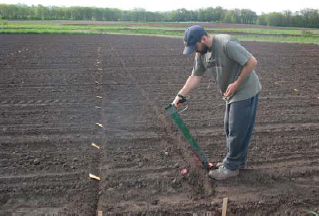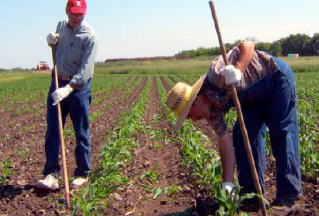Summary
Investigator: William F. Tracy, Dept. of Agronomy, University of Wisconsin,
Madison, WI
Project locations: Wisconsin, Minnesota
Participatory plant breeding to improve sweet corn for organic farmers
In the upper Midwest, fresh market sweet corn is an important part of many diversified organic vegetable operations. Many organic farmers consider sweet corn crucial for attracting customers to their market stands or to their CSAs.
Organic sweet corn growers face many serious challenges, including cold, wet soils that harbor seed-killing pathogens, weed competition, insect damage and diseases. Organic farmers need varieties with superior cold germination, early vigor to out-compete weeds, husk protection against insects, disease resistance, and, of course, high eating quality. The purpose of this project is to develop sweet corn germplasm that answers these needs.In this project, we worked within a participatory plant breeding model. This enables researchers and farmers to work together to develop varieties that exhibit specific traits identified and selected for by the growers. We worked with three experienced organic sweet corn farmers to grow two sweet corn breeding populations in their fields. Selections of corn rows within each population were made based on the ratings the farmers gave for the traits they valued most. Seed saved from the same ears that planted those selected rows were planted in a winter nursery and inter-mated to form the next cycle of selection.
This novel methodology allows the farmers to have complete control over the selection process, while removing the logistical challenges of pollinating and seed saving. It also speeds up the process by allowing a breeding cycle to be completed in one year.
There are four primary objectives related to this long-term project. Conclusive results have not yet been obtained, as this project has four more years before completion. Funding provided by the Organic Farming Research Foundation played a crucial role in initiating this work which has as its main goals:
Objective 1:
Develop improved sweet corn germplasm for organic farmers in the upper Midwest.
Our objective is to obtain an open-pollinated sweet corn with early vigor, high percent germination under cool soil conditions, good eating quality, disease resistance, ear worm resistance, and productivity. Within four years, we aim to see an open-pollinated population that is comparable to the commercially available open-pollinated varieties in our farmer’s fields. Eventually, our goal is to produce open-pollinated varieties that will outperform the best commercial hybrids when grown in organic conditions in the upper Midwest.
Objective 2
Evaluate a novel methodology for participatory plant breeding.
Participatory plant breeding requires a high degree of farmer involvement, direction and control in the breeding process. When breeding out-crossing species such as corn, substantial effort must be taken in the middle of the growing season to ensure that only desirable pollinations occur. Through on-going interviews with our farmer collaborators, we are able to determine the strengths and weaknesses of this system. By creating a way to easily breed out-crossing crops on working organic farms, we hope to expand the breeding efforts for organics, giving us more and better crop varieties for organic farmers.
Objective 3
Improve farmer skills and involvement in on-farm breeding.The three producers engaging in on-farm breeding are gaining the skills and confidence to initiate and manage on-farm breeding projects. They are sharing this knowledge with other growers through annual organic breeding workshops. This project demonstrates to farmers the possibilities of breeding at the farm level.
Objective 4
Train graduate students in participatory plant breeding for organic systems.
Graduate students working at the University of Wisconsin with Dr. Tracy are coordinating this project. They are actively involved in planning the breeding methodology, collaborating with growers, and communicating the results. The future success of organic agriculture depends on such breeders, who will work to develop new varieties for organic and low-external-input systems.


